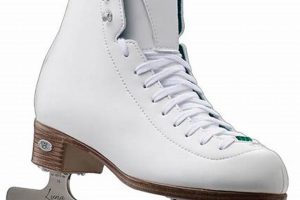Equipment designed to facilitate recreational or fitness activity on paved or unpaved outdoor surfaces, tailored to the anatomical features of female users, allows individuals to experience skating beyond traditional rink environments. These items frequently incorporate features such as softer wheels for shock absorption and enhanced maneuverability, supportive boot structures for ankle stability, and size ranges that accommodate women’s foot dimensions.
The utilization of such equipment offers various advantages, including cardiovascular exercise, improved balance and coordination, and opportunities for social interaction in outdoor settings. Historically, the evolution of skating equipment has led to specialized designs that cater to specific user demographics and activity preferences, reflecting advancements in materials science and biomechanical understanding. The proliferation of designated trails and pathways has further contributed to the accessibility and popularity of this form of recreation.
The subsequent discussion will delve into specific aspects of selecting appropriate skating equipment for external environments, including wheel durometer, boot construction materials, bearing types, and safety considerations. Furthermore, maintenance procedures and best practices for extending the lifespan of these items will be addressed, alongside a review of popular brands and models currently available in the market.
Outdoor Skating Equipment
The following guidelines provide essential information for selecting and maintaining recreational skating equipment designed for female users in outdoor environments. Adherence to these recommendations will enhance performance, safety, and longevity.
Tip 1: Wheel Durometer Consideration: Wheel durometer, measured on the A scale, indicates hardness. Lower durometer ratings (e.g., 78A-82A) provide greater grip and shock absorption on rough surfaces, while higher ratings (e.g., 85A+) offer increased speed and durability on smoother surfaces. Select a durometer appropriate for the anticipated terrain.
Tip 2: Boot Structure Evaluation: The boot should provide adequate ankle support and a snug, comfortable fit. Examine the materials used in boot construction, prioritizing those that offer both durability and breathability. Leather or synthetic materials with reinforced ankle supports are preferable.
Tip 3: Bearing Quality Assessment: Bearings facilitate smooth wheel rotation. ABEC ratings (Annular Bearing Engineering Committee) indicate manufacturing tolerances. Higher ABEC ratings (e.g., ABEC 5 or 7) generally offer greater precision and speed. Regularly inspect and lubricate bearings to maintain optimal performance.
Tip 4: Frame Material Selection: The frame connects the boot to the wheels. Aluminum frames offer superior strength and responsiveness compared to plastic frames. Consider aluminum frames for enhanced performance and durability, particularly on uneven surfaces.
Tip 5: Safety Gear Utilization: Protective gear, including a helmet, knee pads, elbow pads, and wrist guards, is crucial for injury prevention. Ensure that all safety gear fits properly and meets recognized safety standards (e.g., ASTM certification).
Tip 6: Regular Equipment Inspection: Conduct routine inspections to identify signs of wear and tear. Check for loose bolts, worn wheels, damaged bearings, and compromised boot structures. Address any issues promptly to prevent equipment failure.
Tip 7: Cleaning and Maintenance Protocol: Clean equipment regularly to remove dirt, debris, and moisture. Use a soft brush or cloth to clean the boots and frames. Periodically remove and clean the wheels and bearings, applying appropriate lubricants as needed.
Adherence to these guidelines ensures that recreational skating equipment remains in optimal condition, thereby maximizing performance and safety. Proper maintenance and selection are essential components of a safe and enjoyable skating experience.
The subsequent section will address the long term storage and transport recommendations of outdoor skating equipment.
1. Wheel Durometer
Wheel durometer, a measurement of a wheel’s hardness, significantly affects the performance of skating equipment designed for female users in outdoor settings. This parameter, typically measured on the A scale, dictates the wheel’s ability to absorb impacts and maintain grip on varied surfaces. A lower durometer rating indicates a softer wheel, which provides enhanced shock absorption on uneven terrain, thereby increasing rider comfort and control. Conversely, a higher durometer rating signifies a harder wheel, which offers greater speed and durability on smoother surfaces. The selection of an appropriate durometer directly influences the user’s skating experience. As an example, using high durometer wheels on rough asphalt could lead to discomfort and reduced control, whereas low durometer wheels on smooth surfaces might result in decreased speed and efficiency.
The practical significance of understanding wheel durometer extends to optimizing the utility and longevity of skating equipment. Utilizing inappropriately hard wheels on rough surfaces can accelerate wear and tear on both the wheels and the skater’s joints. Selecting softer wheels tailored for outdoor use can mitigate these effects, enhancing the overall skating experience and extending the equipment’s lifespan. Manufacturers often provide durometer recommendations based on anticipated surface conditions. These recommendations serve as valuable guidance for selecting equipment that aligns with specific skating environments. For example, recreational models for outdoor use typically incorporate wheels with a durometer rating between 78A and 85A, striking a balance between shock absorption and rolling efficiency.
In summary, wheel durometer is a critical factor in determining the performance and suitability of skating equipment designed for female users in outdoor environments. Understanding the relationship between durometer, surface conditions, and user comfort is essential for selecting equipment that optimizes the skating experience. This understanding ensures both a more enjoyable ride and the extended lifespan of the skating equipment. The challenges lie in providing clear and accessible information to consumers, enabling them to make informed decisions regarding wheel durometer and overall equipment suitability.
2. Ankle Support
Ankle support, an integral component of skating equipment designed for female users in external environments, directly influences stability, control, and injury prevention. Insufficient ankle support leads to instability, potentially resulting in sprains, strains, or fractures. Conversely, adequate support promotes proper alignment, enhancing skating efficiency and minimizing the risk of lower extremity injuries. Outdoor surfaces often present irregularities, increasing the demand on ankle stability. Equipment with robust ankle support mechanisms mitigates the effects of uneven terrain, allowing skaters to maintain balance and control.
The design and construction of the boot directly correlate with the level of ankle support provided. High-cut boots, reinforced with rigid materials, offer superior stability compared to low-cut, flexible designs. The presence of features such as adjustable straps, buckles, or lacing systems further enhances the ability to customize the fit and optimize ankle support. In real-world scenarios, skaters navigating varied terrain benefit from boots with enhanced ankle support, as these designs compensate for unpredictable surface conditions and reduce the likelihood of ankle instability. Examples include skaters traversing paved trails with cracks or encountering gravel patches, where solid ankle support becomes crucial for maintaining balance and preventing falls.
In summary, the level of ankle support is a critical determinant of safety and performance for female users engaging in outdoor skating activities. Understanding the relationship between boot design, ankle stability, and environmental factors is essential for selecting appropriate equipment. Challenges remain in ensuring consistent manufacturing standards and providing clear guidance to consumers regarding ankle support features and their significance in preventing injuries. Prioritizing designs with robust ankle support mechanisms contributes to a safer and more enjoyable outdoor skating experience.
3. Bearing Precision
Bearing precision, measured via the ABEC (Annular Bearing Engineering Committee) scale or similar ISO standards, directly impacts the rolling efficiency and overall performance of skating equipment designed for women in outdoor environments. Higher ABEC ratings, such as ABEC 5 or ABEC 7, indicate tighter tolerances and more precise manufacturing, resulting in smoother, faster, and more consistent wheel rotation. This, in turn, reduces friction and allows skaters to maintain higher speeds with less effort. The importance of bearing precision is amplified in outdoor settings, where surfaces are often less smooth and consistent than indoor rink environments. Impurities and debris can enter bearings, causing friction and slowing rotation. Higher precision bearings are generally more resistant to these external factors, maintaining their performance characteristics for longer periods. A real-life example demonstrates this principle: a skater utilizing ABEC 3 bearings on a paved trail may experience slower speeds and greater exertion compared to a skater using ABEC 7 bearings on the same trail.
Furthermore, the practical significance of understanding bearing precision extends to the overall lifespan and maintenance requirements of the equipment. Lower-precision bearings are typically more susceptible to wear and tear, requiring more frequent cleaning and lubrication. The increased friction generated by less precise bearings can also lead to increased heat, potentially damaging the bearings or the surrounding components. Outdoor skating often involves varying environmental conditions, including exposure to moisture, dust, and temperature fluctuations. Higher-precision bearings are generally better sealed and protected against these elements, reducing the risk of corrosion and degradation. Regular maintenance, including cleaning and lubrication with appropriate bearing oil or grease, is crucial to preserving bearing precision and extending their lifespan. In addition, the choice of bearing material, such as stainless steel or ceramic, can further enhance resistance to environmental factors and improve overall performance.
In summary, bearing precision is a crucial determinant of the performance, efficiency, and longevity of skating equipment utilized by women in outdoor settings. Understanding the relationship between ABEC ratings, rolling efficiency, and environmental factors is essential for selecting appropriate equipment. Challenges remain in effectively communicating the benefits of higher-precision bearings to consumers and ensuring that equipment is properly maintained to preserve bearing performance. Prioritizing high-quality bearings and implementing regular maintenance routines contribute to a more enjoyable and efficient outdoor skating experience.
4. Frame Material
The selection of frame material is a significant determinant of performance characteristics in skating equipment designed for women in outdoor environments. The frame serves as the structural foundation, connecting the boot to the wheels and influencing stability, responsiveness, and durability.
- Aluminum Alloys
Aluminum alloy frames offer a high strength-to-weight ratio, providing enhanced responsiveness and efficient energy transfer. Examples include 6061 or 7005 aluminum alloys, frequently used in performance-oriented equipment. The rigidity of aluminum facilitates precise control and enables skaters to execute maneuvers with greater accuracy. However, aluminum frames may transmit more road vibrations compared to alternative materials.
- Composite Materials
Composite frames, typically constructed from reinforced polymers, offer a balance between weight, cost, and vibration dampening. These materials, such as fiberglass-reinforced nylon, provide adequate support for recreational skating activities while mitigating road vibrations. However, composite frames generally exhibit lower stiffness and responsiveness compared to aluminum alloys.
- Frame Length and Wheelbase
The frame length, also referred to as the wheelbase, influences maneuverability and stability. Shorter frames enhance agility, facilitating quick turns and tight maneuvers, while longer frames provide greater stability at higher speeds. The selection of an appropriate frame length depends on the skater’s skill level and preferred skating style. For example, shorter frames are often favored by skaters who prioritize agility and responsiveness, while longer frames are preferred by those who value stability and speed.
- Mounting Systems
The mounting system, which attaches the frame to the boot, affects energy transfer and stability. Integrated mounting systems, where the frame is directly integrated into the boot sole, provide a more direct connection and enhance responsiveness. Traditional mounting systems, utilizing bolts or rivets, offer greater adjustability but may compromise energy transfer efficiency.
The interplay of these material properties and design characteristics culminates in a crucial decision impacting both performance and the longevity of equipment designed for external recreational use. Consideration must be given not only to the intended activity level but also to the specific environment. These factors, when properly weighted, determine overall suitability.
5. Protective Gear
Utilization of skating equipment designed for female users in outdoor environments necessitates the implementation of comprehensive protective measures to mitigate injury risks. The unpredictable nature of outdoor surfaces and the potential for collisions with stationary objects or other individuals underscore the importance of appropriate protective equipment.
- Helmet Integration
Helmets are essential for mitigating the risk of head trauma resulting from falls or collisions. Conforming to recognized safety standards (e.g., CPSC, ASTM), a properly fitted helmet absorbs impact energy, reducing the severity of potential head injuries. Helmets should be selected based on head circumference and impact protection characteristics.
- Wrist Guard Utilization
Wrist guards provide support and protection to the wrist joint, a common point of injury during falls. These guards typically consist of a rigid splint or plastic reinforcement that limits wrist extension and flexion, reducing the likelihood of sprains or fractures. Proper fit ensures that the wrist guard remains securely in place during use.
- Knee and Elbow Protection
Knee and elbow pads protect the joints from abrasions, contusions, and more severe injuries resulting from falls onto hard surfaces. Constructed from impact-absorbing materials (e.g., closed-cell foam, hard plastic shells), these pads distribute impact forces and reduce the risk of joint trauma. Correct sizing ensures adequate coverage and mobility.
- Visibility Enhancement
Protective gear incorporating reflective materials or bright colors enhances visibility, particularly in low-light conditions. Increased visibility reduces the risk of collisions with vehicles or pedestrians, especially in urban environments or during early morning or late evening skating sessions. Reflective elements can be integrated into helmets, pads, or clothing.
The integration of these protective measures constitutes a comprehensive safety protocol for female skaters utilizing outdoor skating equipment. The selection of appropriate protective gear, combined with responsible skating practices, minimizes injury risks and promotes a safer outdoor skating experience.
Frequently Asked Questions
This section addresses common inquiries regarding equipment selection, maintenance, and safety for female users engaging in outdoor skating activities. The following questions and answers offer insights into optimizing performance and mitigating potential risks.
Question 1: What wheel durometer is most suitable for uneven paved surfaces?
For uneven paved surfaces, a lower wheel durometer rating (78A-82A) provides enhanced shock absorption and grip, improving stability and comfort. Higher durometer wheels are better suited for smoother surfaces.
Question 2: How often should bearings be cleaned and lubricated?
Bearing maintenance frequency depends on usage and environmental conditions. Generally, bearings should be cleaned and lubricated every 20-40 hours of skating or more frequently if exposed to excessive moisture or debris.
Question 3: What type of ankle support is recommended for beginners?
Beginners benefit from boots with high-cut designs and reinforced ankle supports. Adjustable straps or lacing systems can further enhance stability and control during initial learning phases.
Question 4: Are aluminum frames superior to composite frames for outdoor skating?
Aluminum frames offer greater stiffness and responsiveness compared to composite frames, resulting in improved energy transfer and control. However, composite frames may provide better vibration dampening, enhancing comfort on rough surfaces. The optimal choice depends on individual preferences and skating style.
Question 5: What safety certifications should be sought when purchasing a helmet?
Helmets should comply with recognized safety standards, such as CPSC (Consumer Product Safety Commission) or ASTM (American Society for Testing and Materials) certifications. These certifications indicate that the helmet has undergone rigorous testing and meets specific performance criteria.
Question 6: How can the lifespan of outdoor skating equipment be maximized?
Regular cleaning, proper storage, and timely replacement of worn components can significantly extend the lifespan of skating equipment. Routine inspections for damage or wear are essential for preventing equipment failure and ensuring safety.
Adherence to these guidelines promotes a safer and more enjoyable outdoor skating experience. Prioritizing proper equipment selection and maintenance contributes to long-term performance and injury prevention.
The subsequent section will address alternative forms of skating equipment and their suitability for various outdoor environments.
Conclusion
The preceding analysis has elucidated various factors pertinent to the selection, maintenance, and safe utilization of equipment tailored for female skaters in outdoor environments. Considerations spanning wheel durometer, ankle support, bearing precision, frame materials, and protective gear integration are essential for optimizing performance and mitigating potential risks. A comprehensive understanding of these elements enables informed decision-making, contributing to both user satisfaction and equipment longevity.
Ultimately, responsible engagement with outdoor skating activities necessitates a commitment to safety protocols, diligent equipment maintenance, and a nuanced understanding of environmental conditions. Continued advancements in materials science and biomechanical engineering will undoubtedly yield further refinements in equipment design, enhancing both performance capabilities and user safety. Prospective users are encouraged to prioritize safety certifications and seek expert guidance when selecting equipment to ensure optimal suitability for their individual needs and skating environments.


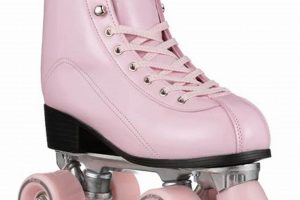
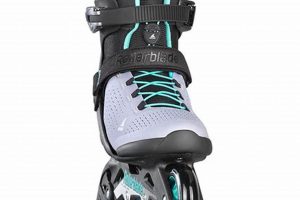
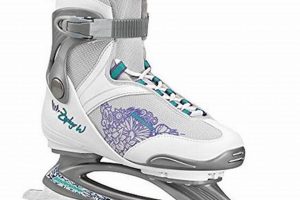
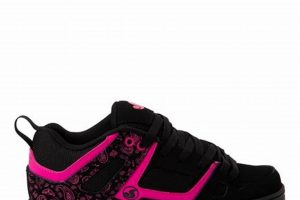
![Top-Rated Best Women's Roller Skates of [Year] - Guide! How to Skateboard: A Beginner's Guide to Your First Board & Tricks Top-Rated Best Women's Roller Skates of [Year] - Guide! | How to Skateboard: A Beginner's Guide to Your First Board & Tricks](https://cruzskateshop.com/wp-content/uploads/2025/09/th-810-300x200.jpg)
